6.2 The role of the operating system
|
Previous
Chapter 5: Social implications of networks
|
Next
Chapter 7: Internet communication tools
|
 CHAPTER OVERVIEW
CHAPTER OVERVIEW
| Unit 6.1 | Computer management |
| Unit 6.2 | The role of the operating system |
| Unit 6.3 | Management of files |
| Unit 6.4 | Troubleshooting your computer |
| Unit 6.5 | Factors that influence performance |
 Learning outcomes
Learning outcomes
At the end of this chapter you should be able to:
- Describe the role of the operating system.
- Discuss file management.
- Identify and explain the uses of operating system utilities.
- List the factors that influence computer performance.
INTRODUCTION
In this chapter, we will look at what an operating system is and why it is important in managing programs. We will also look at how to best manage files and which operating utilities you can use to improve performance. Finally, we will look at some of the factors that may decrease a computer’s performance, as well as some potential solutions.
UNIT
6.1 Computer management
In Grade 10, you learned about file management and how you can use files and folders in order to manage and order your documents.
FILES AND FOLDERS
Files refer to any document that you have created; including text documents, spreadsheets, images and music. These can be distinguished from one another by looking at the file extension. The file extension consists of the letters that follow after the full stop in the file name.
Let’s take a look at some examples of file extensions:
- .txt for text files created in Notepad or other text editors
- .docx (or doc) for files created in Microsoft Word
- .xlsx (or xls) for files created in Microsoft Excel
- .pptx (or ppt) for files created in Microsoft PowerPoint
- .pdf for PDF files that are opened in a PDF reader (such as Adobe Acrobat)
- .html or htm for web pages
- .png, jpg, tiff for images
- .mp3 for music files
- .mp4 for video files
Folders refer to the location where the files are stored on your computer. You can create, name, rename and sort folders, as and when needed. They are usually stored on your hard drive and can be transferred to a USB drive, a CD, DVD, or the internet.
In Grade 11, you learned how to find a specific file and how to obtain additional information about the file. To find a file, you can use your computer’s search function.
To search for a file, you can do the following:
1. Open the Start menu.
2. Type in “File Explorer” and click the File Explorer option. You should now see a new window open.
3. Click the Quick Search box and type in the name of the file for which you are looking. (The Quick Search box is located at the top right-hand part of the window.)
4. Select the correct file from the search results and open by double-clicking the filename.
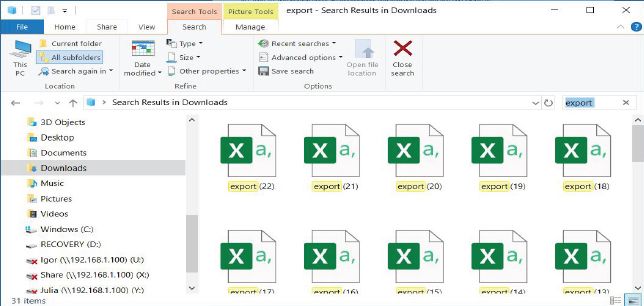
FILE PROPERTIES
Once you have found the file you were looking for, you can obtain some additional information about the file by looking at its file properties. To open the File Properties window, you can do the following:
1. Open the folder where the file is saved.
2. Right click on the selected file to open the drop-down menu with options.
3. Scroll down the menu and select Properties.
4. A new window containing the file information will now open.
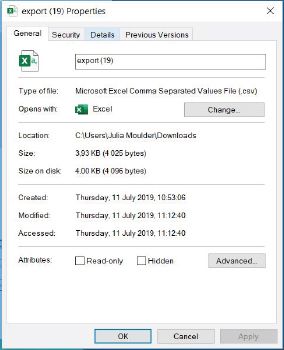
You will notice that the File Properties window consists of the following four tabs:
1. General
2. Security
3. Details
4. Previous versions
Table 6.1: Tabs in the File Properties window
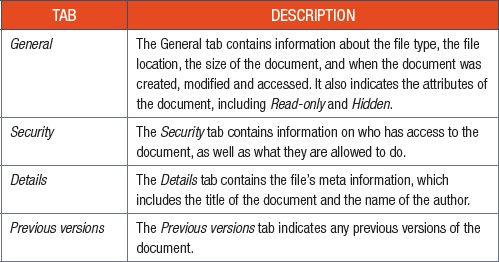
Example 6.1 Work with Read-only and Hidden files
The Read-only attribute allows the user to view, but not edit the file. In order to edit a read-only file, you need to change the file attribute and remove the read-only part. You can do this, by clearing the Read-only checkbox in the File Properties window.
The Hidden attribute makes the file invisible when you browse the folder. In order to view the file, you have to change the folder properties to allow you to view hidden files. This can be done as follows:
1. Open the Start menu.
2. Type in “control panel” and click Control Panel. A new window will open.
3. Click and open the File Explorer options. Your computer will now open a new window.
4. Select the View tab.
5. Under Advanced Settings, click Show hidden files, folders and drives.
6. Click OK.
 Activity 6.1
Activity 6.1
1.Write down the correct answer for each of the following questions.
a.Which one of the following file extensions are NOT used when you type a report?
A..txt
B..docx
C..png
D..pdf
b.Which of the following file extensions are NOT part of the Microsoft Office package?
A..txt
B..docx
C..xlsx
D..pttx
c.Which attribute allows the user to view, but not edit the file?
A.Hidden
B.Read-only
C.Security
D.Sharing
d.Which of the following tabs is not found on the File Properties window?
A.General
B.Security
C.Details
D.Properties
2.Choose a term or concept from Column B that matches the description in Column A. Write only the letter next to the question number.
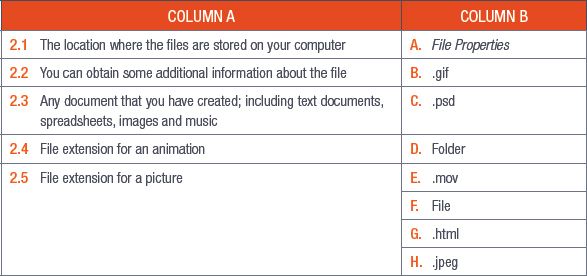
3.Answer the following questions:
a.Define the concept of computer management.
b.List the positive outcomes of computer management.
c.Describe the four tabs visible when the File Properties window is displayed.
d.You want to hide a folder on the school’s PC. List the steps that you will take in order to hide the folder.
e.How do you change the attribute of a file to enable yourself to edit the file?
UNIT
6.2 The role of the operating system
An operating system is a group of system software that is responsible for controlling a computer’s hardware and software, providing a user interface with which to interact and manage the computer’s resources. Due to this, the operating system has a large number of different functions and jobs. To make these functions easier to understand, they will be grouped into different categories based on their goals.
These categories consist of the following:
- Starting the computer
- Providing a user interface
- Managing programs

Something to know
Microsoft’s Windows 10 operating system is estimated to be made up of around 50 000 000 lines of code. In other words, it is made up of 50 000 000 lines of instructions that tell it how to do its job.
STARTING THE COMPUTER
In computing, booting is the process of starting a computer. It can be initiated by hardware such as a button press, or by a software command. After it is switched on, a computer’s central processing unit (CPU) has no software in its main memory, so some process must load softwarIt consists of picture-like items (icons and arrows for example). ...
GUI
The main pieces of a GUI are a pointer, icons, windows, menus, scroll bars, and an intuitive input device. Some common GUIs are the ones associated with Microsoft Windows, Mac OSX, Chrome OS, GNOME, KDE, and Android.e into memory before it can be executed.
PROVIDING A USER INTERFACE
In the past, you needed to know a lot about computers in order to open something as simple as a word-processing program. Fortunately, that has all changed. Today, even toddlers can use computers to open and play their favourite games. This is all thanks to the operating system.

The operating system makes the users’ lives much easier by providing them with a user interface that can be used to interact with the computer. Most modern computers, laptops and smartphones use a graphical user interface (GUI), which allows the user to interact with programs using point-and-click technology.
Examples of a GUI include the following:
- Icons
- Program windows
- Menus
- Tabs on your browser
- Buttons

WHAT HAPPENS WHEN COMPUTER IS TURNED ON (BOOT PROCESS)
MANAGING PROGRAMS
One of the most important tasks of the operating system is to help the computer manage hundreds of processes that run at the same time. In other words, it needs to ensure that theappropriate number of resources is allocated to the processes, as well as the correct hardware is activated when required. An example of this can be seen when listening to music while you are playing games. You want your operating system to allocate the exact number of resources to each of the applications, allowing them to run at the same time. The last thing you want is for your computer to spend half the time playing music and the other half running your game. Fortunately, modern computers are very good at using resources effectively.
It should be noted that there are some circumstances where your computer might run out of resources. This includes running multiple high-intensity processes at the same time. When this happens, close other programs that are not important, or restart your computer. If the problems persist, you may have to buy a more powerful computer with more resources.
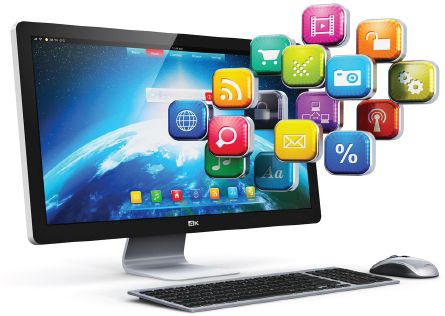
SINGLE VERSUS MULTIPLE USERS
Operating systems can be designed with one or multiple users in mind. Single-user operating systems are normally designed for home and private use, as these computers use software that is licensed for a single user only. This means that only a single person can use the computer at one time. Examples of single-user operating systems include Microsoft Windows and MacOS.

Something to know
A single-user operating system will allow you to create multiple user profiles. However, it will still be limited to only one active user.
Multiple-user operating systems allow more than one user to access and use the computer system at the same time. Because of this, these operating systems are normally used as server. The server computer can be accessed and used by multiple users through a computer network. A mainframe computer uses multiple computer terminals that are connected to the main computer. Examples of multi-user operating systems include Unix and Linux.
MULTITASKING
One drawback of older operating systems is that they were only able to load one program onto the computer’s memory at a time. This means that the computer could only run a single program at a time.
Multitasking operating systems allow the computer to run multiple processes (tasks), or applications at the same time. An example of this can be seen when you use your smartphone. You can listen to music and at the same time, browse the internet, or chat to a friend on WhatsApp. This is not where multitasking stops, however; it also allows certain services to run in the background. These background services allow your smartphone to check for messages, update your applications and manage your cellular network all at the same time.

Something to know
When using a multiple-user operating system, it is important to make sure that you balance the requirements of each user so that the resources of the main computer are shared among the users.
TASK MANAGER (WINDOWS)
In order to find out how a computer is using its resources, Windows operating systems have been designed to include an application called Task Manager. Task Manager allows the user to see which tasks and applications are currently running on the computer, and how much memory and CPU processing power is being dedicated to each individual task. It also allows the user to forcefully end any applications that might have stopped working, or are using too many resources. The Task Manager window consists of several tabs; each dedicated to provide the user with specific information. Table 6.2 lists the description for each of these tabs.

Something to know
One of the reasons why your smartphone’s battery goes flat, even when the screen is turned off and you are not using it, is that your CPU is still running tasks. This includes checking for updates, looking for and downloading messages and emails, and making sure you are connected to an internet-enabled network.
Table 6.2: Tabs in the Task Manager window
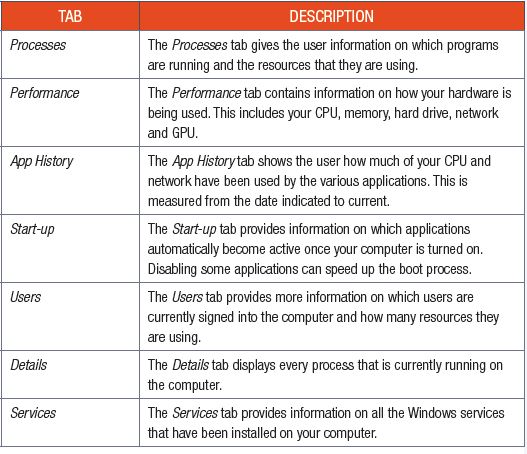
To open the Task Manager, you can do the following:
1. Open the Start menu and enter the words “task manager”.
2. Click on Task Manager.
On most Windows 10 computers, there will be more than 50 applications and processes running at any given time.
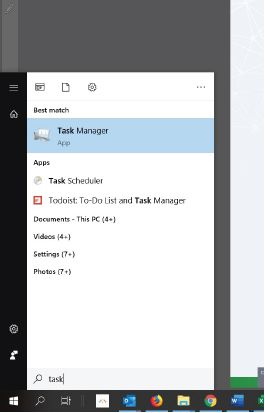
 Activity 6.2
Activity 6.2
1.Write down the correct answer for each of the following questions.
a.Which tab provides information on the applications that automatically become active once your computer is turned on?
A.Start-up tab
B.User tab
C.Process tab
D.Performance tab
b.Which tab provides more information on which users are currently signed in to the computer and how many resources they are using?
A.Performance tab
B.Start-up tab
C.User tab
D.Process tab
c.Which of the following is NOT a GUI?
A.Menus
B.Buttons
C.Icons
D.Backlight
d.Which of the following is a shortcut used to open Task Manager?
A.Alt+F4
B.Ctrl+Shift+Esc
C.Ctrl+Shift+T
D.Ctrl+Shift+D
e.Which application do you use to find out how the computer is using its resources?
A.Task Manager
B.Settings
C.Windows Performance
D.Device Manager
2.Choose a term or concept from Column B that matches the description in Column A. Write only the letter next to the question number.
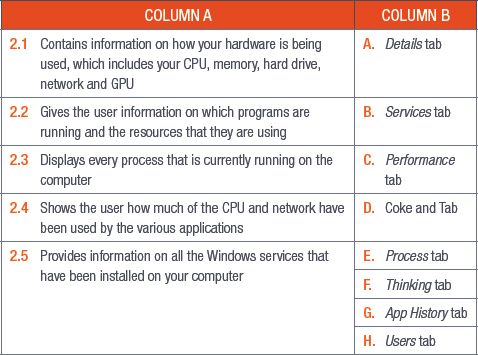
3.Answer the following questions:
a.Explain the role of the operating system.
b.List the three categories into which the functions of the operating system are divided.
c.Provide two ways in which to open Task Manager.
d.Define “multitasking” in terms of a computer operating system.
e.Discuss the difference of single user versus multiple users. Give a user type and a disadvantage that is associated with each.
UNIT
6.3 Management of files
File management ensures that a computer is user friendly, that no files go missing, and that you will be able to find your data and information without wasting any time.
FILE MANAGEMENT
File management allows users to name, organise and arrange their files and folders in such a way that they are easy to find and distinguish. In order to help you with this process, let’s take a look at some tips on effective file management:
- When installing new programs, use the default installation folders. This will ensure that all your programs are installed in the same folder.
- Save all your documents in the same root folder. This also applies to all music (music folder), pictures (images folder) and videos (videos folder).
- Create subfolders within the root folder in order to distinguish between documents.
- Name or rename your folders appropriately. When a folder is created, it will be named “New Folder”. Rename the folder according to the contents of it.
- File new documents as they are created. This will ensure that the document is in the correct folder and, therefore, can be found with more ease.
- Remove old documents and folders. Old documents and folders can take up space and cause your computer to become cluttered. In order to prevent this, you should delete documents and folders that are no longer needed. If you do not want to delete them, consider creating a root folder called “oldies” and moving all old documents to that folder.
- Make regular backups of important files. This will prevent you from losing any important information.
IMPORTING AND EXPORTING
Modern operating systems allow you to import and export files, documents and data. Importing a file refers to bringing a file from a different program into the one that you are currently using. An example of this is when you import information from a Microsoft Excel (.xls) file to Microsoft Word (.doc). Exporting a file refers to saving the file in a way so that it can be used by a different program. This normally includes converting the file format to one that is usable by the program. An example of this is exporting a file from Microsoft Word (.doc) to a PDF reader (.pdf).
Importing and exporting can also be used to manage files and documents on your computer or smartphone. This is best illustrated when exporting your contacts from your smartphone and transferring the data to your Google account (this can also be used to back-up the data). Once the data has been uploaded, you can import the contacts to your computer, tablet, or new smartphone.
 Activity 6.3
Activity 6.3
1.Briefly explain the following
a.Spooling
b.Firewall
c.Spoofing
d.File compressors
2.Choose a term or concept from Column B that matches the description in Column A. Write only the letter next to the question number.
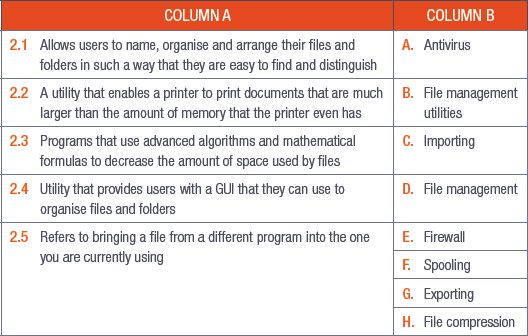
3.Answer the following questions:
a.Give two main reasons why it is good to constantly keep your computer programs updated.
b.List two reasons why file compression is rarely used.
c.Explain “converting” and give an example of when it is implemented.
OPERATING SYSTEM UTILITIES
Most operating systems include various system utilities. These utilities are small programs that work with the operating system in order to help users maintain and protect their computers. The following are some of the most commonly used utilities:
- Firewall
- File compressors
- File management utilities
- Update schedulers
- Backups
FILE COMPRESSORS
File-compression programs use advanced algorithms and mathematical formulas to decrease the amount of space used by files. While this sounds like a great way to free storage space, in reality, file compression is rarely used to free storage space. There are two important reasons for this:
1. Compressed files cannot be used immediately; they first need to be decompressed. Not only does this waste time every time you open up a file; it uses up the space you saved when you compressed the files in the first place.
2. The files most likely to use up your storage space are already compressed. This includes most video and music files. As such, compressing them further does not help.
Compression is, however, useful to archive files. When many files and folders are grouped together into a single file, they are said to be archived. This makes them easier to store or transfer. For example, it is a lot easier to email a single archived file than thousands of separate files. Since a single compressed file can contain thousands of files and folders, they are often used to archive files.
FILE MANAGEMENT UTILITIES
File management utilities provide users with a GUI that they can use to organise files and folders. Operating systems, such as Windows, use a variety of different GUI options to enable users to customise files and folders to best suit their needs.
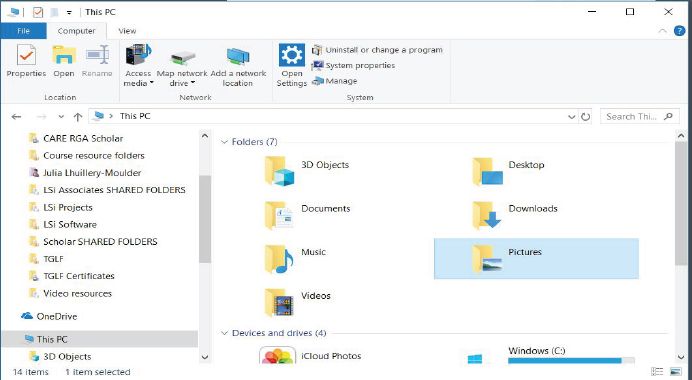
SCHEDULING UTILITY
In today’s competitive market, computer programmers continue to improve their software after they have been released. This includes adding new features, fixing bugs, improving system reliability or security. In order to obtain these improvements, the user needs to update the software, or download a patch from the supplier’s website.
If an application or operating system asks you if it can automatically install an update, the best idea is to simply allow it to do so. This takes a few minutes to complete, but ensures that your computer is up to date with the newest software. Since updates are so important for software, saying no to an update will cause the application to constantly remind (and annoy) you about the update, until you eventually allow it. As such, it is better to update the application as soon as possible.
The Scheduling Utility is located in the System ribbon menu. The new Scheduling feature provides savings in both time and human resources and greatly improves the efficiency with which you can automate repetitive and time consuming activities. The three areas controlled by this utility are Report Scheduling, Email Alerts and Process Scheduling.
BACKUP UTILITIES
Operating systems, such as Windows, come equipped with a backup and restore utility. This program allows users to back up important files and folders, as well the important settings for the operating system. To use Backup and Restore, you can do the following:
1. Purchase an external hard drive to use for the backup and connect it to your computer.
2. Open the Start menu and type in “control panel”. This will open the Control Panel.
3. Click Backup and Restore (in Windows 7) to open the Backup and Restore window.
4. Click Set up backup.
5. Select the external hard drive as the location where you would like to save the backup.
6. If all your files are stored in your private folders (such as the Documents, Music and Videos folders), let Windows choose. Otherwise, select the folders that should be backed up manually.
7. Click Save and run the backup option to create a backup of all your files.
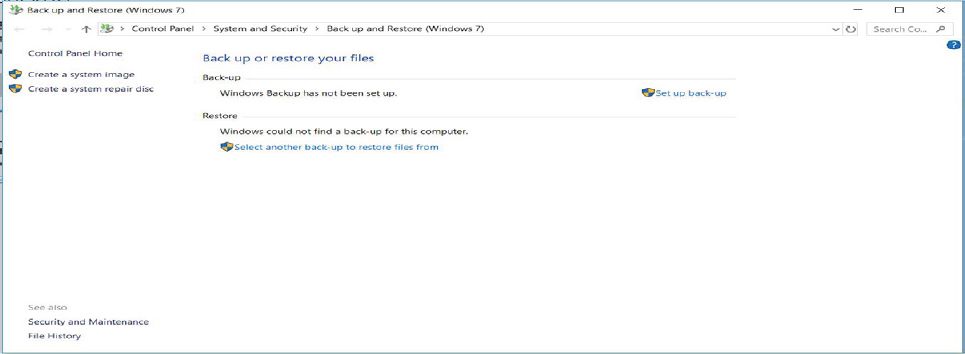
To restore files from a Windows backup, you can do the following:
1. Connect your external hard drive to your computer.
2. Open the Backup and Restore (Windows 7) application from the Control Panel.
3. Click Restore all users’ files.
4. Click Browse for files or Browse for folders.
5. Select in the original location box and click Restore.
6. This will restore your files to where they used to be; therefore, the files are no longer deleted.
DEFRAGMENTATION
When you save a file onto your computer, the computer breaks the file up into smaller pieces. This is done so that the file can be stored on your hard drive. Unfortunately, the file pieces are not always stored in the same location, but rather spread over several locations. When this happens, it is known as fragmentation.
Fragmentation occurs from files being constantly written, deleted and resized, and can lead to several problems. These include a slow computer, long boot-up times, random computer crashes and the computer freezing. In order to prevent these problems from happening, you can defragment your hard drive. This process reorganises your hard drive by taking all the pieces of data that are spread across your hard drive and reorganising it so that the pieces are closer to each other.
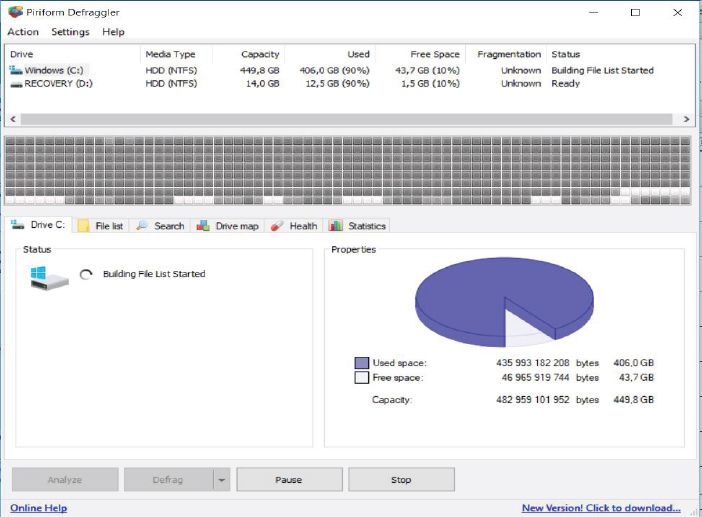

DEFRAGMENTATION EXPLAINED
To show the Disk Deframenter process, watch the following video:

Examples of programs that you can use to defragment your computer include the following:
- Optimise Drive Tool, which comes with the Windows operating system and was previously known as Disk Defragmenter
- PerfectDisk
- Norton Utilities
SPOOLING
Spooling is a process in which data is temporarily held to be used and executed by a device, program or the system. Data is sent to and stored in memory or other volatile storage until the program or computer requests it for execution.
“Spool” is technically an acronym for simultaneous peripheral operations online.
Spooling works like a typical request queue or spool where data, instructions and processes from multiple sources are accumulated for execution later on. Generally, the spool is maintained on the computer’s physical memory, buffers or the I/O device-specific interrupts.
The spool is processed in ascending order, working on the basis of a FIFO (first in, first out) algorithm.
The most common implementation of spooling can be found in typical input/output devices such as the keyboard, mouse and printer. For example, in printer spooling, the documents/ files that are sent to the printer are first stored in the memory or printer spooler. Once the printer is ready, it fetches the data from that spool and prints it.
 Activity 6.4
Activity 6.4
1.Choose a term or concept from Column B that matches the description in Column A. Write only the letter next to the question number.

2.Answer the following questions:
a.Explain the process of fragmentation and defragmentation.
b.Explain how a troubleshooting wizard works.
UNIT
6.4 Troubleshooting your computer
In Chapter 1, we looked at some of the potential problems (and solutions) that you might encounter while using a computer. So, in order to make your life even easier, in this section, we will be taking a look at some of the utility software that you can use in order to resolve your computer problems.
UTILITY SOFTWARE FOR TROUBLESHOOTING
DISK CLEAN-UP
Sooner or later, you are going to encounter the problem of running out of hard-drive storage space. When this occurs, the Disk Clean-up utility can be a very handy tool to free up some hard-drive space. The tool comes standard with Microsoft Windows and works by identifying different types of files that can be deleted without affecting you. These include temporary files, the files in your Recycle Bin and the files used as part of a completed software upgrade. Once the Disk Clean-up tool has identified the files, it lets you decide which files can be deleted.

RUN DISK CLEANUP
To show the Disk Clean-up process, watch the following video:

To use the Disk Clean-up tool, you can do the following:
1. Click the Start menu.
2. Type in “disk clean-up” and select Disk Clean-up. Your computer will calculate how much space you can free up.
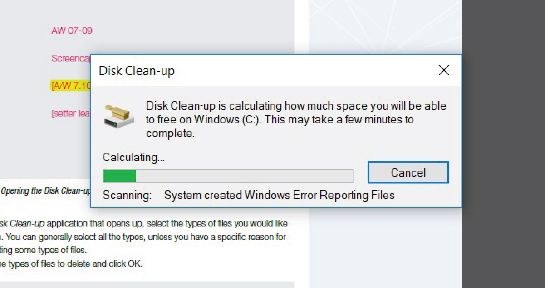
3. In the Disk Clean-up application that opens up, select the types of files you would like to delete. You can generally select all the types, unless you have a specific reason for not deleting some types of files.
4. Select the types of files to delete and click OK.
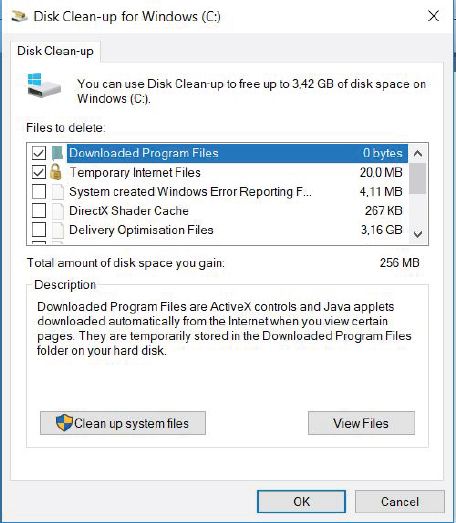
The amount of space cleaned up with this application will depend on how regularly you use it. If you rarely use the Disk Clean-up tool, it can free up a few gigabytes at a time. However, if you use it regularly, it may only free a few megabytes at a time.
WIZARDS
Troubleshooting can be a time-consuming and annoying procedure; fortunately, your operating system can fix this. Troubleshooting wizards are system utilities that come standard with your operating system. The tool allows you to quickly check if your operating system or hardware is functioning as required. If a problem is encountered, the wizard will attempt to fix it. If the wizard cannot fix the problem, it will ask you some questions in order to determine the cause of the problem.
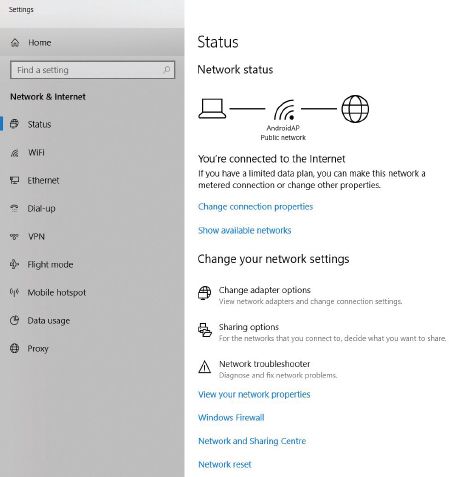
Examples of problems that can be fixed using the troubleshooting wizards include network connection problems, printing problems and software compatibility problems.
UNIT
6.5 Factors that influence performance
As you are most likely aware, you use your computer a lot. Due to this, the computer is subject to some wear and tear, which can reduce its speed and performance. In order to help you determine why your computer is becoming slower, we will be taking a look at some of the most common factors that might influence computer performance.
RAM
RAM is responsible for temporarily storing the data that is being used by the computer’s processor. This allows the processor to access the data much faster and easier than would be possible if the data was loaded from a secondary storage device, such as a hard drive.
A slow computer can be an indication that you have too little RAM. This can be solved by buying and adding additional RAM to your computer. If you are looking to buy additional RAM, do proper research regarding the speed and type of RAM that is used by your motherboard.

FIXING YOUR SLOW COMPUTER
To show why a computer becomes slow, watch the following video:

PROCESSOR
The CPU is the part of a computer that is responsible for receiving and carrying out a computer’s instructions. Because of this, the CPU is one of the most important components for determining how fast a computer will be.
There are two main factors that influence the speed of the CPU:
1. The first is the GHz of the processor, which refers to the CPU frequency and is an indication of the processor speed. As a general guideline, the higher the frequency, the better the CPU.
2. The second factor is the amount of cores. As with processor speed, more cores are generally better.

Something to know
More RAM allows more data to be stored in the RAM, which allows your programs to run faster.
APPLICATIONS
Every computer has a limited number of resources (such as RAM and CPU processing time) that can be used to run applications. For each application currently running, the amount of available resources will become less. If you open too many applications at the same time, all available resources will be used up and your computer’s processing speed will slow down significantly. This might even lead to some applications freezing entirely.
In order to prevent this from happening, close any application that you are not currently using. You can do this by using the Task Manager application, as described earlier in this chapter.
CACHING
One of the methods that your computer uses in order to improve processing speed is caching. Caching is a small, temporary form of storage that is created in a fast form of memory in order to allow data to be accessed more quickly. An example of this can be seen when you are browsing the internet. When you open a website, such as Facebook, your computer temporarily stores the files for the website in your cache. Next time you open Facebook, the files are loaded from the cache instead of the internet. This not only helps the site to load faster; it also reduces the burden on your network.
Your computer uses the following three forms of caching:
1. CPU cache: The difference in speed between a computer’s CPU and RAM has recently become too large. As a result, the RAM cannot provide all the information the CPU needs fast enough. To prevent this problem, many CPUs now have a small, high-speed cache built into the CPU, where it can temporarily store the data it needs.
2. Disk cache: The disk cache is a small amount of RAM that is built into a hard-disk drive. It stores data that is being sent or received by the hard-disk plates for a short period of time.
3. Web cache: The web cache is a small area on a computer’s hard drive where images and pages from the world-wide web are stored for a short period. This allows you to quickly load those images from your computer when you visit the page again, rather than to wait to have them load over a slow internet connection.
DISK OPTIMISATION
As discussed previously in this chapter, fragmentation of data can cause your computer to slow down. To prevent this from happening, you can use a defragmentation tool to reorganise the data on your hard drive. This will rearrange the areas where data is stored on the hard drive to make sure the pieces of a file are close to each other and that the fastest parts of the hard drive are used.
Another potential problem that you might encounter is running out of storage space. When this happens, you have the following options:
- Delete any files that you do not need any more.
- Use the Disk Clean-up application to help create some additional space.
- Buy an additional hard drive.

Something to know
Computers are not limited to a single hard drive. If you are running low on storage space, do not hesitate to buy an additional hard drive to store more data.
MALWARE
As discussed in Chapter 5, malware has been designed to cause harm and use your computer’s resources without your knowledge. Due to this, malware is often responsible for slowing down your computer. In order to prevent malware from infecting your computer, or to remove any malware that might already be installed on your computer, you can use security applications, such as a firewall, antivirus and anti-spyware.
A processor, or “microprocessor,” is a small chip that resides in computers and other electronic devices. Its basic job is to receive input and provide the appropriate output. While this may seem like a simple task, modern processors can handle trillions of calculations per second.

Something to know
Windows 10 comes equipped with a basic firewall and antivirus program. If you feel that you will need additional protection, Chapter 6 has some recommendations on which programs to buy.
The central processor of a computer is also known as the CPU, or “central processing unit.” This processor handles all the basic system instructions, such as processing mouse and keyboard input and running applications. Most desktop computers contain a CPU developed by either Intel or AMD, both of which use the x86 processor architecture. Mobile devices, such as laptops and tablets may use Intel and AMD CPUs, but can also use specific mobile processors developed by companies like ARM or Apple.
Modern CPUs often include multiple processing cores, which work together to process instructions. While these “cores” are contained in one physical unit, they are actually individual processors. In fact, if you view your computer’s performance with a system monitoring utility like Windows Task Manager (Windows) or Activity Monitor (Mac OS X), you will see separate graphs for each processor.
Processors that include two cores are called dual-core processors, while those with four cores are called quad-core processors. Some high-end workstations contain multiple CPUs with multiple cores, allowing a single machine to have eight, twelve, or even more processing cores.
Besides the central processing unit, most desktop and laptop computers also include a GPU. This processor is specifically designed for rendering graphics that are output on a monitor. Desktop computers often have a video card that contains the GPU, while mobile devices usually contain a graphics chip that is integrated into the motherboard. By using separate processors for system and graphics processing, computers are able to handle graphic-intensive applications more efficiently.
 Activity 6.5
Activity 6.5
1.Which of the following refers to cache located on the CPU?
a.Disk cache
b.CPU cache
c.Web cache
d.Motherboard cache
2.Answer the following questions:
a.Define RAM.
b.Explain what influences a CPU’s speed.
c.What can potentially happen if you open too many applications at the same time?
d.Describe how cache improves performance.
e.List three ways in which you can free up disk space.
f.What is meant by a CPU’s generation and how does this affect its speed?
REVISION ACTIVITY
QUESTION 1: MULTIPLE CHOICE
1.1Where can you search for additional information about a file? (1)
A.Properties
B.Windows Explorer
C.Security tab
D.Start menu
1.2Which of the following tabs is only found in the Properties window of a folder? (1)
A.General
B.Security
C.Details
D.Location
1.3When a computer is started up the operating system is loaded into the _______. (1)
A.ROM
B.RAM
C.Hard disk
D.Cache
1.4Which of the following is not on a smartphone’s GUI? (1)
A.Browser tabs
B.Buttons
C.Settings menu
D.Mouse icon
1.5Which of the following troubleshooting utilities is used to increase your computer’s storage capacity? (1)
A.Defragmentation tool
B. Disk Clean-up tool
C.Wizard tool
D.Antivirus software
[5]
QUESTION 2: TRUE OR FALSE
Indicate if the following statements are TRUE or FALSE. Correct the statement if it is false. Change the underlined word(s) to make the statement true.
2.1Multitasking operating systems allow more than one user to access and use the computer system at the same time. (1)
2.2A new computer’s performance increases over time. (1)
2.3The write-only attribute allows the user to view but not edit the file. (1)
2.4Print management allows a printer to print documents that are much smaller than the amount of memory the printer has. (1)
2.5CPU cache is high-speed memory stored on CPU that is larger than RAM. (1)
[5]
QUESTION 3: MATCHING ITEMS
Choose a term or concept from Column B that matches a description in Column A.
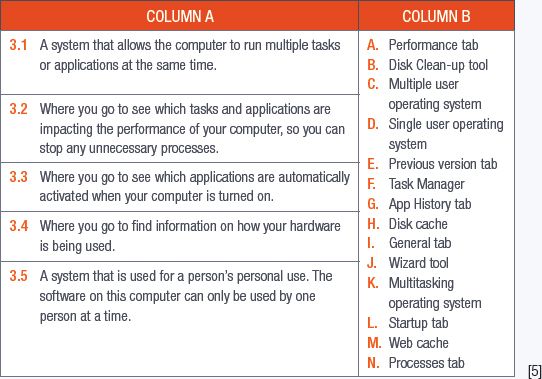
QUESTION 4: MEDIUM AND LONG QUESTIONS
4.1How can a wizard be used to improve the troubleshooting process? (3)
4.2What is a multitasking operating system? (2)
4.3Mention TWO situations where your computer can run out of resources. (2)
4.4Mention ONE profession that would use a single user operating system. Give a reason for your answer. (2)
4.5Mention ONE profession that would use a multiple user operating system. Give a reason for your answer. (2)
TOTAL: [21]
AT THE END OF THE CHAPTER

|
Previous
Chapter 5: Social implications of networks
|
Table of Contents |
Next
Chapter 7: Internet communication tools
|


